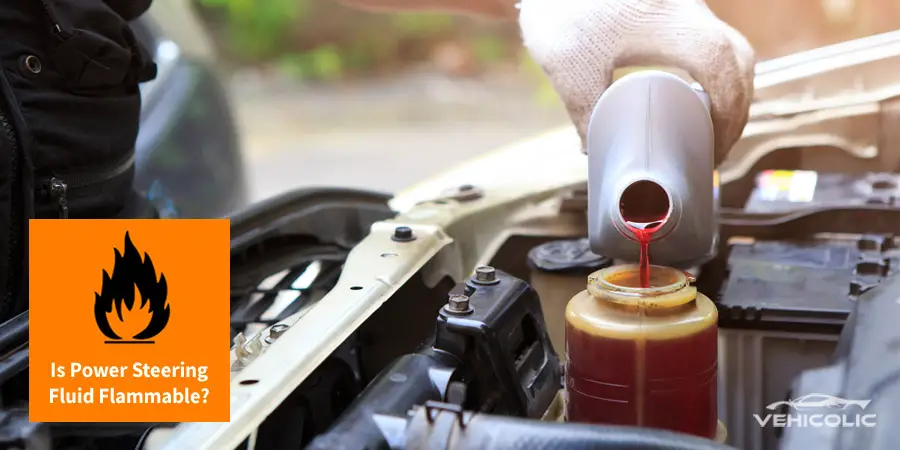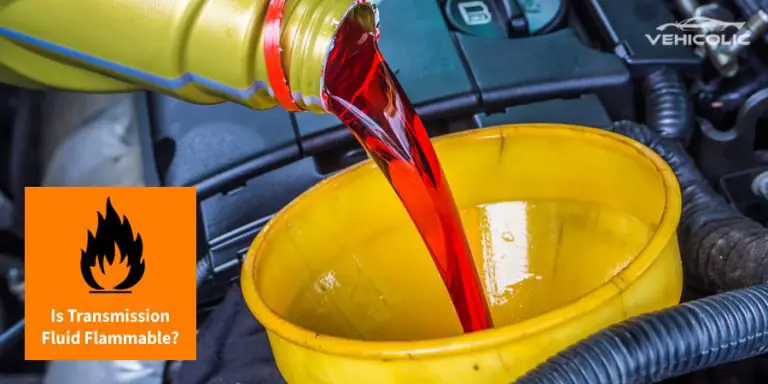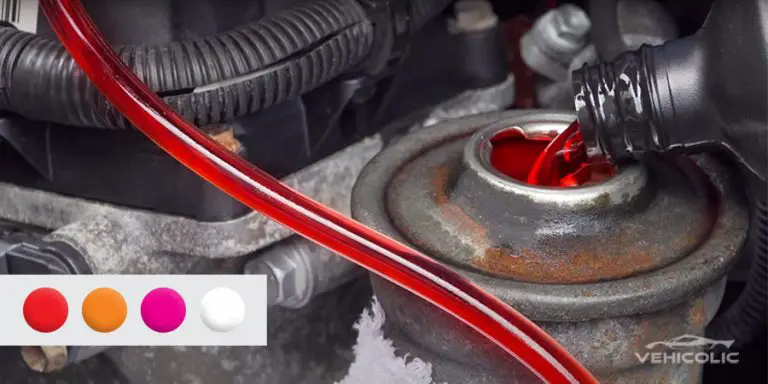Is Power Steering Fluid Flammable?
The power steering fluid is a significant invention in the automobile industry. The fluid reduces the effort exerted when steering the car.
You bet it is flammable! It has 33-45% methanol and 55-67% water compositions, enabling it to play a vital role in the power transfer in the transmission system. But at the same time makes it flammable.
It would be best if you upheld safety in garages, workshops, or vehicles to avoid the looming fire hazard.
The power steering fluid is flammable but to a lower degree than most excessively flammable liquids such as gasoline.
Some people call the power steering fluid combustible instead of flammable because of the high flash point.
What is the purpose of a power steering fluid?
The fluid in your car’s power steering system is a combination of three primary components: a hydraulic fluid, a thickener or viscosity modifier, and a lubricant.
Combining these fluids, you get an ideal amount of resistance when you turn the steering wheel; too much resistance, and it is more difficult to turn your wheels; too little, and the steering is too loose.
You can use power steering fluid for indefinite periods, but if power steering fluid becomes contaminated, it will lose its effectiveness.
For instance, if it becomes contaminated with water, it will begin to lose its effective viscosity, making it more difficult to control your vehicle.
What Is the Flammability of Power Steering Fluid?
If you have been following auto industry news, you will recall that a few years back, a car manufacturer recalled thousands of cars because of a possible leak problem that posed a fire hazard.
After this particular event, many drivers, car enthusiasts, and other interested parties started wondering whether power steering fluid can catch fire.
Power steering fluid can catch fire if the temperature is right because the fluid is indeed flammable.
So how do I know if a fluid is flammable? To determine flammability, look at the flashpoint. For flammable fluids, the boiling point is higher than the flashpoint.
The flashpoint for this fluid is 300-500 degrees Fahrenheit, and the boiling point stands at 600-700 degrees Fahrenheit. The disparity means the fluid ignites when it heats up to between 300 and 500 degrees Fahrenheit.
How to Safely Handle Power Steering Fluid?
Safe handling of power steering fluid is vital since the fluid is flammable. Also, it is not corrosive but can remove paint from certain areas it gets in contact with on the car.
Follow the tips below to handle the power steering fluid safely.
- Keep the fluid far from fire sources to avoid the vapors igniting a fire below the flashpoint.
- Label the fluid correctly to make identification easy and avoid confusion.
- Dispose of the fluid properly in an appropriate waste disposal site and method.
- Store the power steering fluid far from the reach of kids or pets.
- Clean off any spills immediately using a laundry detergent or a brake cleaner.
- Be careful about leaks by observing signs of leaks like the steering system making squeaking noise or having difficulty turning your steering wheel.
How to Detect Power Steering Fluid Leaks
The fluid reservoir is responsible for holding the power steering fluid. The fluid lubricates your steering gear and ensures you can easily steer the vehicle. When you turn your steering wheel, the pump pushes the power steering fluid into your car steering gear.
Consequently, the gear applies pressure which steers your tires, allowing your car to negotiate a corner smoothly. Detecting leak problems with your steering fluid relies on watching out for signs mentioned below:
Leaks Under the Vehicle
Check the ground under the car for signs of amber or clear fluid leak. Take a small portion and smell it. Power steering fluid has a burnt marshmallow smell.
After confirming that your power steering fluid is leaking, call a mechanic immediately to inspect the reservoir. The professional will advise you on the right action.
Clean the leaked fluid on the ground because it’s a hazard.
Lack of Steering
When you start experiencing problems turning the steering wheel, sometimes the car is not responding when you steer it. You may have a fluid leak in the reservoir, which caused a drop in the fluid level. It means you need to fill it up after repairing the leak.
Don’t drive your vehicle before repairing it because it will be difficult to turn, which can cause accidents.
Hearing Squeaking Noise when Turning
If you hear noises when negotiating a corner, you may notice a drop in fluid pressure because air is getting into the system due to a low power steering fluid level in the reservoir.
Low fluid levels and air make the pump fail to work perfectly.
Top up the fluid and get to the bottom of the low fluid level problem. Possibly, you are dealing with a crack or leak in your reservoir.
Make repairs to prevent power-steering system failure. Contact your mechanic to do an inspection and diagnose the problem.
Frequently Asked Questions
Is power steering fluid corrosive?
No. The transmission fluid is not corrosive. However, the fluid can sometimes remove the paint from the surfaces it is in contact with when it leaks.
Is power steering fluid dangerous?
Most definitely yes. It’s the main reason you should pay attention to any leaks to avoid fire hazards. However, it’s sporadic for the fluid to be the leading cause of car fires.
In most cases, it’s the secondary cause of the fire because of the hot temperature making the fluid vaporize and ignite.
The burning steering fluid releases harmful gases like sulfur, phosphorus oxides, carbon dioxide, and carbon monoxide gases.
Is the power steering fluid the same as the transmission fluid?
No. Power steering fluid lubricates power steering parts, applies hydraulic pressure to enable steering, and reduces temperature buildup. Telling the two fluids apart is easy besides their uses.
Transmission fluid is a red liquid and has a distinct sweet smell, while power steering fluid is clear, pinkish, and amber, and it smells like a burning marshmallow.
However, both are hydraulic fluids, and some vehicle manufacturers acknowledge the usage of transmission fluids in the power steering pump.
Always check the vehicle manufacturer’s recommendations.
Can the power steering fluid evaporate?
Only when the fluid reaches its flashpoint. The vapor easily ignites itself when the flashpoint is reached, primarily because of its viscosity and flammability.
Can power steering fluid burn off?
The fluid can burn off your engine if there is a leak and the temperature is high enough to vaporize it. It can be a deadly scenario. Contact between the fluids and hot surfaces is a potential cause of a fire.
What happens if you add too much power steering fluid?
Most modern vehicles have a mechanism that allows the power-steering system to relieve excess pressure, like a vent letting out extra pressure while putting less strain on your car.
The average power steering pump runs between 1000 psi and 1500 psi on the higher side, which is ten times the amount of pressure in the engine cylinders and more than the pressure in the brakes.
The pressure needs room to grow hence the air gap in the fluid reservoir. Overfilling doesn’t cause blow seals, foaming, or over-pressure.
How long should the power steering fluid last?
There is no lifespan for this fluid. However, it’s advisable to change it after every two years or after every 50000 miles. Look at the vehicle manufacturer manual on the frequency of replacement.
Proper maintenance can make the fluid last the lifespan of your car. Generally, it doesn’t last longer than 100,00 miles.
Is power steering fluid universal?
Some power steering fluids are universal and we can use them in most power steering systems. The fluids have special additives that improve the performance and responsiveness of the system by reducing the stiffness and friction of the components.
Can you drive without power steering?
It’s unwise because you will be risking your life. It’s difficult turning the steering wheel, which makes you more prone to accidents.
How do you know if your car needs power steering fluid?
Firstly, by watching out for signs like noisy steering when driving. Check your fluid level because it can be low.
Also, you experience jumpy power steering and difficulty turning your steering wheel. Sometimes, you see stains or puddles under your vehicle when in parking.
Final Thoughts
Power steering fluid is a vital innovation in the automotive industry, which makes steering your vehicle easy. The fluid is utility in the transmission system, as it plays a crucial role in power transmission.
The fluid flammability means you should handle leaks carefully and give them the urgency it deserves. Make timely repairs to prevent secondary fires as much as power steering fluids rarely start primary vehicle fires.






